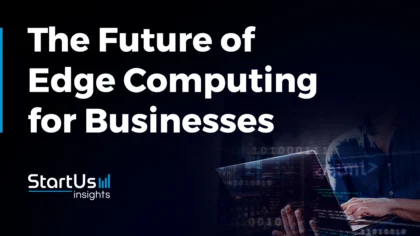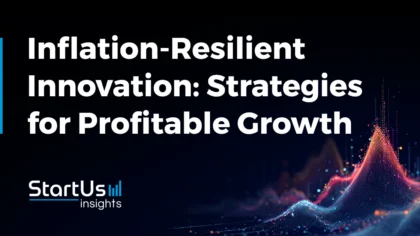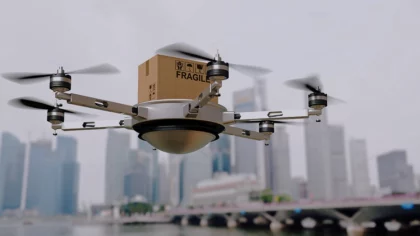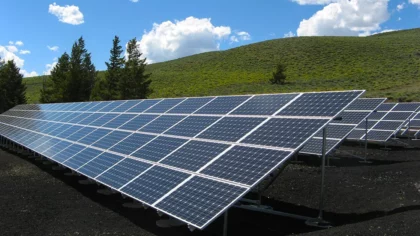Accelerate Productivity in 2025
Reignite Growth Despite the Global Slowdown
Are you curious how edge computing for businesses is impacting the industry landscape? Edge computing tackles climate change through real-time data analytics at remote locations. Urban planning also benefits from processing data locally for smart city management. Autonomous vehicles and mobility systems use edge computing for instant decision-making and improved traffic management. The rise of Industry 5.0 sees edge computing offering real-time factory floor analytics and smart agriculture management.
As industries scale toward zero-emission systems, edge computing reduces energy consumption. Healthcare applications benefit from edge computing’s real-time patient monitoring and immediate medical interventions. Moreover, as businesses navigate uncertain geopolitical conditions, local edge computing provides data security and system resilience. Learn how emerging edge computing technologies are paradigm-shifting industries for the next wave of digital evolution.
Why should you read this report?
- Gain insights into the top edge computing innovations impacting businesses.
- Discover 30+ edge computing application areas.
- Learn about 10+ innovative startups offering breakthrough solutions.
Key Takeaways
- Tackling Climate Change
- Use Cases:
- Energy Management in Smart Grids
- Precision Agriculture
- Industrial Emissions Monitoring
- Startup to Watch: Deep Green
- Use Cases:
- Navigating Demographic Shifts
- Use Cases:
- Smart Healthcare for Aging Populations
- Smart City Infrastructure for Urbanization
- Remote Work and Education
- Startup to Watch: TentiCL
- Use Cases:
- Rapid Urbanization
- Use Cases:
- Smart Traffic Management
- Waste Management Optimization
- Energy Grid Monitoring
- Startup to Watch: VSaaS.ai
- Use Cases:
- The Energy Transition
- Use Cases:
- Smart Grid Management
- Renewable Energy Integration
- Predictive Maintenance for Energy Infrastructure
- Startup to Watch: Molecule Systems
- Use Cases:
- Future of Mobility
- Use Cases:
- Autonomous Vehicle Operations
- Intelligent Traffic Management
- Vehicle-to-Everything (V2X) Communication
- Startup to Watch: AIWaysion
- Use Cases:
- Hyper-Connectivity
- Use Cases:
- Smart Cities
- Industrial Automation
- Healthcare Devices
- Startup to Watch: Robotto
- Use Cases:
- Rise of Technology & Industry 5.0
- Use Cases:
- Collaborative Robots (Cobots)
- AI-Driven Quality Control
- Personalized Manufacturing
- Startup to Watch: Green Edge Computing Corp
- Use Cases:
- Shifting Economic Trend
- Use Cases:
- Remote Work Infrastructure
- Supply Chain Optimization
- Retail Automation
- Startup to Watch: EdgeNectar
- Use Cases:
- Innovating to Zero
- Use Cases:
- Energy Management
- Precision Agriculture
- Waste Management
- Startup to Watch: Hortica
- Use Cases:
- Health and Wellness Evolution
- Use Cases:
- Wearable Health Devices
- Remote Patient Monitoring
- Telemedicine
- Startup to Watch: Driq
- Use Cases:
- Managing Social Instability
- Use Cases:
- Secure Communication Networks
- Border Surveillance
- Supply Chain Resilience
- Startup to Watch: Parasanti
- Use Cases:
- Navigating the Fracturing World
- Use Cases:
- Remote Equipment Monitoring
- Disaster Response Coordination
- Environmental Impact Monitoring
- Startup to Watch: Captain Coach
- Use Cases:
FAQs: Top Edge Computing Applications in Businesses
How is edge computing for businesses used?
Edge computing is used in various industries for data processing and to improve operational efficiency. Businesses deploy sensors and gateways, to collect and analyze data closer to its source, reducing latency and bandwidth usage. For example, in manufacturing, edge computing facilitates real-time monitoring of equipment performance for immediate responses to anomalies and minimizing downtime. Similarly, in retail, companies use edge computing to manage inventory and improve supply chains by processing data on-site.
What is the future of edge computing in businesses?
The future of edge computing in businesses looks promising, with trends indicating growth and adoption across sectors. As IoT devices proliferate, the need for localized data processing intensifies, driving investments in edge computing infrastructure. Further, developments in AI and machine learning improve edge capabilities. This shift allows businesses to derive actionable insights from data in real time while fostering innovation and improving decision-making processes.
How We Identify Emerging Technologies & Startups
The data in this report originates from StartUs Insights’ Discovery Platform, covering 4.7 million global startups, scaleups, and technology companies, alongside 20,000 emerging technology trends. Our platform makes startup and technology scouting, trend intelligence, and patent searches more efficient by providing deep insights into the technological ecosystem. Utilizing the trend intelligence feature, we analyze industry-specific technologies for this report, detect patterns and trends, and identify use cases along with the startups advancing these areas. Further details and capabilities are accessible via the website.
Top 12 Ways Edge Computing is Advancing Businesses [2025 & Beyond]
1. Tackling Climate Change
Edge computing impacts the climate change industry by solving data processing and real-time analytics challenges. Companies deploy local units at remote monitoring stations for on-site data analysis, reducing latency and bandwidth. Edge solutions integrate with sensors to monitor variables like temperature, humidity, and pollution. Decentralized architectures further distribute data processing across multiple nodes. This technology increases organizations’ ability to track and respond to climate change with precision and speed.
3 Practical Use Cases of Edge Computing in Tackling Climate Change
- Energy Management in Smart Grids: Edge computing offers real-time data processing and analysis for smart grids to optimize energy distribution and reduce wastage. This leads to more efficient energy use, lowering emissions, and increasing grid stability during peak demands.
- Precision Agriculture: By deploying edge computing devices in agricultural fields, farmers monitor soil, water levels, and crop health in real-time. This provides more sustainable farming practices and reduces resource consumption and carbon footprints.
- Industrial Emissions Monitoring: Edge computing allows factories to track and analyze emissions data at the source in real time. This allows industries to identify inefficiencies quickly, reduce pollutants, and support compliance with environmental regulations.
Startup to Watch: Deep Green
Deep Green is a UK-based startup that provides CPUs and GPU clusters configured to meet the high-performance demands of supercomputing. This company delivers AI inference through distributed edge data centers with resilient hyper-connected networking. The setup combines colo and bare metal services with below-market rates for energy consumption. The company also addresses decarbonization by zeroing scope 3 emissions, with real-time reporting. Its distributed network minimizes latency for optimal computing placement that benefits both businesses and communities. Additionally, Deep Green repurposes the heat generated from computing operations for social good, at no extra cost. Further, this commitment allows the company to provide HPC & supercomputing, hybrid cloud solutions, AI computing, and more.
2. Navigating Demographic Shifts
Rapid urbanization strains city infrastructure and services. Edge computing processes data directly at the source, such as in smart city sensors, reducing latency and bandwidth. This improves real-time urban management and infrastructure planning. Additionally, an aging population needs better healthcare access and personalized care. Edge devices in remote monitoring systems analyze health data on-site, offering immediate feedback. Decentralized data analytics also process demographic data quickly. Edge solutions align public services like water and waste management by processing data locally. Organizations using edge computing can adapt faster and more precisely to demographic changes.
3 Practical Use Cases of Edge Computing in Demographic Shifts
- Smart Healthcare for Aging Populations: Edge computing offers real-time health monitoring and diagnostics for elderly patients through connected devices. This improves access to care, reduces hospital visits, and supports independent living for aging populations.
- Smart City Infrastructure for Urbanization: Edge computing supports the development of smart cities by processing data from urban infrastructure like traffic lights and public services locally. This reduces congestion and improves city planning and the quality of life in rapidly growing urban areas.
- Remote Work and Education: The technology provides real-time collaboration for remote work and online learning in geographically dispersed areas. Edge computing encourages adapting to changing demographic needs, and improving access to education and employment in underserved communities.
Startup to Watch: TentiCL
US-based company TentiCL delivers edge computing solutions through its data center-in-a-box technology. This solution is shifting the way organizations deploy and manage compute, storage, and network resources. The company’s platforms use converged and hyper-converged infrastructure to simplify IT infrastructure. The platform allows fast deployment and easy capacity scaling across dispersed locations. By offering preconfigured systems with self-healing, high availability, and hybrid cloud capabilities, TentiCL ensures that businesses focus on operations without IT expertise. Its edge-ready micro data centers provide low-latency, high-bandwidth performance, and are adaptable to diverse environments. The data centers feature eco-friendly designs for businesses managing the growing demands of edge computing in dynamic markets.
3. Rapid Urbanization
Edge computing platforms address the influx of data from traffic cameras, sensors, and IoT devices by processing it at or near the source. This reduces latency and eases the burden on central servers. In real-time applications, edge computing reduces latency and ensures critical systems remain operational even during network disruptions. It also offers privacy by keeping data local, minimizing the risk of breaches. By decentralizing data processing, edge computing boosts efficiency and supports resilient urban infrastructure.
3 Practical Use Cases of Edge Computing in Rapid Urbanization
- Smart Traffic Management: Edge computing offers real-time data processing from traffic sensors and cameras to manage congestion efficiently. This leads to a reduction in traffic jams and an increase in road safety by making instant adjustments to traffic signals and rerouting vehicles.
- Waste Management Optimization: Edge devices in waste bins monitor fill levels and optimize collection routes based on real-time data. This ensures timely waste removal, reduces fuel consumption, and lowers operational costs for city services.
- Energy Grid Monitoring: Edge computing localizes power grid data processing, detects outages, and manages energy distribution more effectively. It delivers quicker responses to issues, increases energy efficiency, and supports renewable energy integration into the grid.
Startup to Watch: VSaaS.ai
Chile-based company VSaaS.ai provides a smart city video surveillance platform using artificial intelligence as a service. It uses existing infrastructure, including both analog and IP cameras, to offer real-time video streaming and surveillance through edge AI computing. The technology supports centralized management of video feeds, integrates with various camera manufacturers, and provides operator assistance with AI-driven real-time event management and traceability. The company offers massive scalability, compatibility with 99% of existing infrastructure, and the ability to connect urban, business, and residential cameras. Its agnostic platform connects with any cloud provider and supports a wide range of hardware architectures. By utilizing edge AI, the company reduces centralized data center costs and ensures easy operation even in challenging network conditions.
4. The Energy Transition
The shift to renewable energy creates challenges in data management and integration. Edge computing addresses this by processing data locally from sources like wind turbines and solar panels. It reduces potential latency and performance issues from the vast data generated by smart grids. Edge platforms offer real-time analysis for immediate adjustments and system stability. They also reduce network strain by processing data locally while integrating diverse energy sources and offering reliable energy operations.
3 Practical Use Cases of Edge Computing in the Energy Transition
- Smart Grid Management: Edge computing allows real-time monitoring and optimization of smart grids to balance supply and demand. This improves energy efficiency by reducing power outages and enabling dynamic load balancing.
- Renewable Energy Integration: This technology allows real-time data processing at renewable energy sources like wind farms and solar plants. This accelerates decision-making, stabilizes energy output, and improves grid reliability.
- Predictive Maintenance for Energy Infrastructure: Edge computing detects anomalies in critical energy infrastructure by processing sensor data locally. This reduces downtime and maintenance costs by predicting failures before they occur.
Startup to Watch: Molecule Systems
Molecule Systems is a US company that specializes in an end-to-end platform to enable virtual power plant (VPP) and proper management of energy. The company provides access to edge technologies and distributed energy resource (DER) markets and automates energy operations using the cloud. Integrating a single API, this company makes market entry easy and eliminates separate infrastructure needs. Its MosEMS-Cloud offers an energy management system and is hardware-free. Meanwhile, MosEMS-Edge allows real-time device control for valuable assets without relying on cloud connectivity. This solution also offers battery storage and EV charger management.
5. Future of Mobility
Edge computing impacts mobility by addressing data latency, integration complexity, and bandwidth limits. It processes information locally for vehicles and infrastructure to respond instantly. Autonomous vehicles use edge computing for real-time sensor data analysis and immediate decisions. By reducing data transmission, edge computing supports driver-assistance systems (ADAS) and manages traffic flow through smart infrastructure. This decentralized approach brings efficiency, reduces congestion, and keeps mobility systems adaptive in dynamic urban environments.
3 Practical Use Cases of Edge Computing in the Future of Mobility
- Autonomous Vehicle Operations: The technology provides real-time data processing from sensors in autonomous vehicles for faster decision-making. This improves safety and responsiveness by reducing latency in vehicle control systems.
- Intelligent Traffic Management: Edge computing supports real-time analysis of traffic data to optimize signal control and reduce congestion. This results in smoother traffic flow and fuel efficiency for vehicles.
- Vehicle-to-Everything (V2X) Communication: Edge computing offers instant communication between vehicles, infrastructure, and pedestrians. This improves road safety by allowing real-time hazard detection and collision avoidance.
Startup to Watch: AIWaysion
US-based startup AIWaysion develops next-generation connected vehicle technology and smart mobility solutions using artificial intelligence and edge computing. The company integrates computer vision and sensor fusion with multi-sensor technologies, such as cameras and environment sensors, to enhance smart transportation systems. It employs AI and deep learning algorithms to process data on-device for real-time operations and accurate responses. Its communication and data management solutions provide real-time cellular communication (4G, 5G, C-V2X) with traffic management centers, road users, and infrastructure. This technology supports a range of applications including connected vehicles, rural road safety, traffic and roadway conditions monitoring, vehicle-to-infrastructure interactions, smart parking, curb management, and more.
6. The Hyper-Connected World
Edge computing addresses the demand for rapid data processing and low latency in a hyper-connected world. In smart cities, the technology offers real-time analysis of data from IoT devices like traffic cameras and sensors for better urban management. In healthcare, edge computing supports remote patient monitoring by processing data locally. This allows for timely interventions and reduces reliance on centralized data centers. By offering efficiency and responsiveness, edge computing transforms data usage across sectors.
3 Practical Use Cases of Edge Computing in the Hyper-Connected World
- Smart Cities: Edge computing powers real-time data processing for smart city applications such as traffic management and public safety systems. It offers faster decision-making and reduces network latency while improving urban efficiency and citizen experiences.
- Industrial Automation: Factories use edge computing to monitor machinery and improve production lines through predictive maintenance. This reduces equipment downtime, increases operational efficiency, and lowers maintenance costs.
- Healthcare Devices: Edge computing supports real-time processing in medical devices, such as continuous glucose monitors and smart implants. It improves patient care by enabling instant data analysis and also reduces cloud-based data transmission delays.
Startup to Watch: Robotto
Robotto is a Danish company that develops robotics solutions that offer autonomous operations through vision-based navigation and AI detection. Its technology uses sensors and cameras for real-time data processing on-site for robots to make quick decisions in various environments. The company’s products, Robotto Hub and Robotto Brain, align operations by integrating with aerial and ground robots. They provide actionable insights for applications ranging from wildlife protection to safety and security operations. Additionally, Robotto BioMeasureAI manages biomass by calculating stockpile volumes and detecting high heat pockets. Plus, the OmniSight system improves aerial surveillance capabilities with fast, AI-driven detection.
7. Rise of Technology & Industry 5.0
Edge computing is a Canadian startup that drives Industry 5.0 by solving data processing and real-time response challenges. In manufacturing, it allows on-site analytics for immediate machinery adjustments based on sensor data. In smart agriculture, this technology processes drone and IoT data locally. This provides farmers with timely insights to manage crops efficiently. By reducing latency and bandwidth issues, edge computing allows faster decision-making and less dependence on cloud services. This supports Industry 5.0’s focus on blending technology with human expertise for better operational efficiency.
3 Practical Use Cases of Edge Computing in the Rise of Technology & Industry 5.0
- Collaborative Robots (Cobots): Edge computing improves cobots by allowing real-time communication and coordination between humans and machines in manufacturing environments. This leads to faster response times, greater safety, and precision in production processes.
- AI-Driven Quality Control: The technology processes data from sensors and cameras directly on factory floors to detect defects in products as they are made. This accelerates quality checks and reduces waste by identifying issues early in the production cycle.
- Personalized Manufacturing: Edge computing offers customizable production by analyzing consumer data and machine performance in real-time for on-demand manufacturing. This allows for more flexible production schedules and rapid adjustments that cater to individual customer needs efficiently.
Startup to Watch: Green Edge Computing Corp
Green Edge Computing Corp is a Canadian company that introduces a compact, low-power modular edge computing appliance. It improves data processing, management, and networking for edge-focused workloads in challenging environments. The company’s EdgePod integrates into diverse industries such as industrial, commercial, defense, and space to provide a high-performance platform. EdgePod also supports digital twins, AI inference, IIoT data streams, and real-time decision-making. Its modular design reduces training and maintenance costs while lowering the size, weight, and power requirements compared to conventional IT equipment. Besides, by enabling local data storage and processing, the EdgePod also offers minimal latency.
8. Navigating the Shifting Economic Trends
The rapid growth of business and consumer data strains traditional processing and storage systems. Edge computing tackles this by reducing data transfer and storage needs. As industries depend on real-time data, delays in processing impact efficiency and competitiveness. Edge computing speeds up decision-making by enabling local data analysis and reducing latency. Increased data transfers raise the risk of breaches, but edge systems with built-in encryption and threat detection protect sensitive information. This technology also supports distributed infrastructure that adapts to changing processing demands. Additionally, with edge computing, industries handle large data volumes more efficiently.
3 Practical Use Cases of Edge Computing in Shifting Economic Trends
- Remote Work Infrastructure: The technology supports remote work with faster data processing and hassle-free collaboration through distributed computing power. Edge computing technology reduces dependency on central cloud services which further leads to cost savings and productivity for businesses.
- Supply Chain Optimization: Edge computing processes data from IoT sensors in real-time to monitor and improve supply chain operations. It allows companies to respond swiftly to disruptions to manage inventory and reduce operational costs.
- Retail Automation: The edge computing technology allows real-time data analysis in retail settings, such as automated checkout systems and inventory tracking. This improves customer experiences and reduces business labor costs to adapt to economic fluctuations and consumer demands.
Startup to Watch: EdgeNectar
EdgeNectar is a US-based startup that delivers private mobile networks tailored for enterprise 5G connectivity. Its technology connects locations where traditional Wi-Fi and fixed broadband fall short. The company provides customized installations that allow organizations to manage their domains securely while ensuring fast data transmission. With low-latency performance, EdgeNectar’s networks support critical applications in sectors like healthcare, smart agriculture, and community services. Its solutions include data collection and storage options, remote monitoring capabilities, and network management features that enforce custom security policies.
9. Innovating to Zero
Traditional data processing models consume excessive energy and limit efficiency. Edge computing reduces data transfer to central servers by minimizing energy use from long-distance transmission. Data delays hinder timely responses and affect zero-emission systems’ performance. By processing data locally, edge devices offer real-time insights and immediate adjustments. As zero-emission systems grow, centralized infrastructure faces scalability challenges. Edge computing reduces latency and improves the responsiveness of zero-emission technologies. Moreover, edge devices distribute tasks, ease server loads, and boost scalability.
3 Practical Use Cases of Edge Computing in Innovating to Zero
- Energy Management: Real-time monitoring and control of energy consumption in smart grids and buildings optimize energy use. This reduces waste and supports zero carbon emissions by integrating renewable energy sources more efficiently.
- Precision Agriculture: Edge computing processes data from sensors and drones in agricultural fields to improve resource use, such as water and fertilizers. This boosts crop yield and sustainability while minimizing environmental impact and reducing waste.
- Waste Management: Edge computing supports smart waste management systems by analyzing data from sensors in waste bins and collection vehicles. This improves route planning and waste sorting, leading to a reduction in landfill use and a boost in recycling rates.
Startup to Watch: Hortica
Israeli startup Hortica develops microenvironment cultivation solutions for indoor agriculture. It leverages its proprietary Environment within Environment (EwE) technology to create double-closed environments. This technology improves crop quality while reducing energy costs and environmental impact. By employing sensors and software systems, including AI and autonomous actions, the company processes vast amounts of data at the edge of the Hortica Cloud. This approach generates operational information, alerts, notifications, and real-time visual images for growers to produce high-yield crops year-round.
10. Health and Wellness Evolution
Edge computing improves health and wellness by tackling key data processing and real-time analytics challenges. It processes health data at the source by minimizing long-distance data transfers while improving processing speed. With continuous real-time monitoring, edge computing offers immediate detection of abnormalities and timely treatment. Further, processing data locally reduces latency, leading to faster response times in critical health applications. This local approach also limits data transmission over networks and decreases the risk of data breaches. Besides, the technology meets the industry’s demand for efficient, scalable, and reliable data management solutions.
3 Practical Use Cases of Edge Computing in Health and Wellness
- Wearable Health Devices: Data from wearable health devices, like fitness trackers and smartwatches, is processed directly on the edge computing device. This allows for real-time health monitoring and alerts, speeding up responses to health issues and improving overall wellness.
- Remote Patient Monitoring: Edge computing aids real-time data analysis from remote patient monitoring devices, like glucose monitors and heart rate sensors. This allows timely interventions and personalized treatment adjustments for better management of chronic conditions and patient outcomes.
- Telemedicine: Edge computing supports telemedicine platforms by managing and processing data locally during virtual consultations. This reduces latency and offers secure, high-quality video and data transmission for effective remote healthcare services.
Startup to Watch: Driq
Driq, a US-based company offers an incontinence monitoring solution with its world’s first battery-free disposable smart brief for senior living. It deploys a reusable DriQ Tag, which integrates with adult briefs of various brands to detect and communicate instances of “wet events” to the cloud. This system utilizes edge-computing and AI technologies within the DriQ hub to monitor both the state of the diaper and the patient’s condition for secure and encrypted communication. The DriQ Tag employs patented RFID technology and electromagnetic principles to identify diaper states without direct contact. By connecting with nursing station consoles, the system issues real-time alerts and also predicts trends. This connection improves the management of urinary incontinence in long-term care facilities and hospitals.
11. Managing an Uncertain Geopolitical Future
Geopolitical uncertainty increases and cyber-attack and data breach risks. Data processing at the edge reduces insecure network dependency. Also, centralized data processing delays decision-making during unstable geopolitical situations. Edge computing provides immediate data analysis at the source for quicker responses. Moreover, unfavorable geopolitical conditions impact network reliability. Distributing data processing across multiple edge devices reduces dependence on centralized systems. Also, localized data processing limits the exposure of sensitive information. Edge computing technologies thus combat risks linked to data management and bring system resilience during geopolitical threats.
3 Practical Use Cases of Edge Computing in an Uncertain Geopolitical Future
- Secure Communication Networks: Edge computing strengthens secure communication networks by processing sensitive data locally. This boosts data security and offers reliable communication even in volatile regions.
- Border Surveillance: Border surveillance systems analyze data from cameras and sensors in real-time using edge computing. This improves threat detection and response times and increases security and monitoring in high-risk areas.
- Use Case 3: Edge computing increases supply chain resilience by allowing real-time tracking and management of goods and logistics. This offers rapid adjustments to disruptions and greater continuity in the face of geopolitical uncertainties.
Startup to Watch: Parasanti
US-based startup Parasanti offers edge computing solutions for military operations. It improves the effectiveness of edge devices without relying on cloud connectivity. By optimizing workload orchestration and data translation, the company addresses the challenges of interoperability and latency within defense technology. Its flagship software manages customer-provided workloads while creating the necessary runtime environments for execution at the edge. Moreover, this approach minimizes space, weight, and power requirements that align operations in critical environments.
12. Navigating the Fracturing World
Edge computing tackles several fracturing world challenges like time limitations, real-time data processing, and operational reliability. This technology offers immediate adjustments and real-time analysis that combat data processing issues on time. By processing data locally, edge computing minimizes the volume of information sent over networks. This further improves data management, and time constraints, and also minimizes data transmission needs over insecure networks. Edge computing supports operations in remote locations that maintain functionality even with unreliable network connectivity. In addition, this technology diminishes fracturing operations by delivering more reliable and quicker data processing capabilities.
3 Practical Use Cases of Edge Computing in the Fracturing World
- Remote Equipment Monitoring: Edge computing monitors equipment in hazardous and rural environments in real time. This offers reliable equipment and also reduces downtime by delivering alerts and insights on equipment status immediately.
- Disaster Response Coordination: Disaster response is supported by processing data from sensors and drones in affected areas through edge computing. This boosts awareness and coordination for more effective emergency responses.
- Environmental Impact Monitoring: Environmental sensors process data to track industrial impact on ecosystems with edge computing. This technology makes effective decisions and reduces environmental damage while also ensuring regulatory compliance.
Startup to Watch: Captain Coach
Captain Coach is a Greek startup that develops digital solutions for independent living and healthy aging through its project, XGain. This project narrows urban-rural digital disparities by using 5G technology, last-mile connectivity, and edge computing solutions. The project deploys eHealth robots and 5G-connected drones to monitor agricultural needs. These solutions provide guidance and interventions for the elderly. XGain also emphasizes eco-friendly and cost-effective approaches while tackling inadequate network infrastructure and high service prices.
Act Now to Take Advantage of the Latest Edge Computing Innvations
Top investors like Techstars, Y Combinator, and Google for Startups support startups focusing on edge computing innovatons. They provide crucial funding that drives innovation. This funding majorly spans seed, early-stage VC/series A, accelerator/incubator, and M&A rounds. Whereas, the average funding per round stands at USD 13 million, supporting early-stage startups developing edge computing solutions,
Take immediate action on the top emerging edge computing technologies to stay ahead in the industry. StartUs Insights empowers you to uncover hidden opportunities among 4.7 million startups and tech companies, alongside insights into 20,000 technologies and trends. Our AI-powered, real-time database provides unparalleled access to solutions that are not available elsewhere, ensuring you always lead in innovation.
Major companies like Samsung, Nestlé, and Magna rely on our tools to spearhead trends and optimize operations. Dive into unmatched data and benefit from a 360-degree industry view for actionable insights. Get in touch with us now to discover how our innovation intelligence can elevate your strategic initiatives.
Discover All Edge Computing Innovations & Startups!







